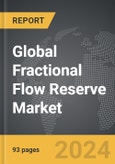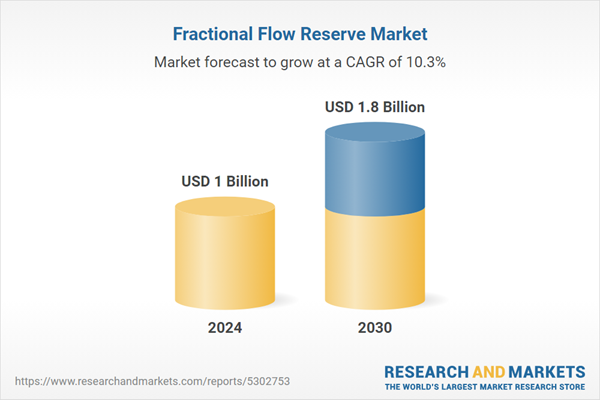Global Fractional Flow Reserve (FFR) Market - Definition, Key Trends & Drivers Summarized
What Is Fractional Flow Reserve (FFR) and Why Is It Gaining Popularity in Cardiovascular Care?
Fractional Flow Reserve (FFR) is a medical technique used to measure the blood pressure differences across a coronary artery stenosis, helping physicians determine the severity of blockages in the heart's blood vessels. But why is this method gaining traction in modern cardiovascular care? FFR provides precise, real-time data that allows doctors to assess whether a stenosis is causing ischemia (a restriction of blood flow), helping to decide if a patient needs stenting or other intervention. Traditionally, angiography has been the go-to method for visualizing coronary artery disease, but it only offers a structural view. FFR, on the other hand, gives functional information, allowing for a more tailored approach to treatment. With cardiovascular disease being a leading cause of death globally, there is increasing emphasis on diagnostic methods that not only improve patient outcomes but also reduce unnecessary procedures. As a result, the demand for FFR-guided decision-making is on the rise, particularly in high-risk patients, making it a pivotal tool in the interventional cardiology market. Its ability to reduce healthcare costs while improving the accuracy of treatment has also driven widespread adoption, especially in developed healthcare systems.How Are Technological Advancements Revolutionizing Fractional Flow Reserve (FFR) Diagnostics?
Recent advancements in technology are revolutionizing the field of fractional flow reserve (FFR), making it more accessible and accurate. But how exactly are these innovations shaping the future of cardiovascular diagnostics? Traditionally, FFR measurements required the use of guidewires equipped with sensors to assess blood flow pressure differences. However, the rise of non-invasive FFR technologies, such as computed tomography-derived FFR (FFR-CT), is transforming the landscape. FFR-CT allows physicians to calculate FFR from standard CT scans without the need for invasive procedures, reducing patient discomfort and risk. This development is particularly significant for patients with complex or multiple comorbidities, where minimizing surgical intervention is crucial. Another technological advancement driving growth in the FFR market is the integration of advanced software analytics that enhances the speed and accuracy of FFR data interpretation, enabling real-time decision-making during procedures. Moreover, new-generation FFR guidewires are being developed with improved flexibility and sensitivity, making them easier to navigate through the intricate coronary anatomy. These technological innovations are not only enhancing diagnostic accuracy but are also expanding the application of FFR in more clinical settings, making it an essential tool in personalized cardiovascular treatment.How Do Regulatory Standards and Economic Factors Impact the FFR Market?
How do regulations and economic factors influence the adoption of fractional flow reserve (FFR) technology in healthcare systems worldwide? Regulatory bodies like the U.S. Food and Drug Administration (FDA) and the European Medicines Agency (EMA) have stringent guidelines that govern the approval and use of FFR devices, ensuring safety and efficacy in clinical settings. The increasing regulatory approval of non-invasive FFR technologies, such as FFR-CT, has accelerated their adoption in many regions, as they offer a safer alternative to invasive diagnostic procedures. Furthermore, the healthcare cost savings associated with FFR-guided interventions are becoming a key economic driver for its adoption. FFR helps reduce the number of unnecessary stent placements and surgeries by providing accurate functional assessment, which translates to lower procedural costs and reduced patient recovery times. This has made FFR particularly attractive in healthcare systems where cost-efficiency is paramount, especially in regions like North America and Europe. Additionally, reimbursement policies are increasingly accommodating FFR procedures, encouraging wider use in clinical practice. As healthcare providers and policymakers prioritize outcome-based care, FFR is becoming a critical tool in improving both clinical and economic outcomes in cardiovascular treatment.What Are the Key Drivers Behind the Growth of the Fractional Flow Reserve (FFR) Market?
The growth in the fractional flow reserve (FFR) market is driven by several key factors, including technological advancements, an aging population, and the increasing prevalence of cardiovascular diseases. First, the development of non-invasive FFR technologies, such as FFR-CT, has made it easier for clinicians to assess coronary artery disease without invasive catheterization, increasing the accessibility and appeal of FFR diagnostics. As global populations age, the prevalence of cardiovascular diseases is rising, particularly in regions like North America, Europe, and Asia-Pacific, where heart disease remains the leading cause of death. This demographic shift is pushing healthcare providers to adopt more precise diagnostic tools like FFR to manage complex cases of coronary artery disease more effectively. Additionally, the growing emphasis on reducing healthcare costs and improving patient outcomes has made FFR a valuable tool in avoiding unnecessary stenting and surgeries, which are both costly and risky. Changing consumer behavior, including the increasing awareness among patients about minimally invasive procedures, is also driving demand for FFR-guided interventions. Furthermore, improvements in healthcare infrastructure, particularly in developing countries, are expanding the availability of advanced FFR technologies in previously underserved markets. Collectively, these factors are propelling the global FFR market forward, as healthcare providers increasingly rely on it to deliver more accurate, efficient, and personalized cardiovascular care.Report Scope
The report analyzes the Fractional Flow Reserve market, presented in terms of market value (US$ Thousand). The analysis covers the key segments and geographic regions outlined below.- Segments: Type (Invasive, Non-Invasive); Product Segment (FFR Guidewires, FFR Monitoring Systems); Application (Single-Vessel Diseases, Multi-Vessel Diseases).
- Geographic Regions/Countries:World; United States; Canada; Japan; China; Europe (France; Germany; Italy; United Kingdom; Spain; Russia; and Rest of Europe); Asia-Pacific (Australia; India; South Korea; and Rest of Asia-Pacific); Latin America (Argentina; Brazil; Mexico; and Rest of Latin America); Middle East (Iran; Israel; Saudi Arabia; United Arab Emirates; and Rest of Middle East); and Africa.
Regional Analysis
Gain insights into the U.S. market, valued at $260.9 Million in 2024, and China, forecasted to grow at an impressive 13.2% CAGR to reach $398.4 Million by 2030. Discover growth trends in other key regions, including Japan, Canada, Germany, and the Asia-Pacific.Why You Should Buy This Report:
- Detailed Market Analysis: Access a thorough analysis of the Global Fractional Flow Reserve Market, covering all major geographic regions and market segments.
- Competitive Insights: Get an overview of the competitive landscape, including the market presence of major players across different geographies.
- Future Trends and Drivers: Understand the key trends and drivers shaping the future of the Global Fractional Flow Reserve Market.
- Actionable Insights: Benefit from actionable insights that can help you identify new revenue opportunities and make strategic business decisions.
Key Questions Answered:
- How is the Global Fractional Flow Reserve Market expected to evolve by 2030?
- What are the main drivers and restraints affecting the market?
- Which market segments will grow the most over the forecast period?
- How will market shares for different regions and segments change by 2030?
- Who are the leading players in the market, and what are their prospects?
Report Features:
- Comprehensive Market Data: Independent analysis of annual sales and market forecasts in US$ Million from 2024 to 2030.
- In-Depth Regional Analysis: Detailed insights into key markets, including the U.S., China, Japan, Canada, Europe, Asia-Pacific, Latin America, Middle East, and Africa.
- Company Profiles: Coverage of players such as Abbott, Acist Medical Systems (Subsidiary of Bracco Diagnostic Inc), Boston Scientific Corporation, Cathworks, Heartflow, Inc. and more.
- Complimentary Updates: Receive free report updates for one year to keep you informed of the latest market developments.
Some of the 42 companies featured in this Fractional Flow Reserve market report include:
- Abbott
- Acist Medical Systems (Subsidiary of Bracco Diagnostic Inc)
- Boston Scientific Corporation
- Cathworks
- Heartflow, Inc.
- Koninklijke Philips N.V.
- Medis Medical Imaging Systems Bv
- Opsens
- Pie Medical Imaging
- Siemens Healthineers
This edition integrates the latest global trade and economic shifts into comprehensive market analysis. Key updates include:
- Tariff and Trade Impact: Insights into global tariff negotiations across 180+ countries, with analysis of supply chain turbulence, sourcing disruptions, and geographic realignment. Special focus on 2025 as a pivotal year for trade tensions, including updated perspectives on the Trump-era tariffs.
- Adjusted Forecasts and Analytics: Revised global and regional market forecasts through 2030, incorporating tariff effects, economic uncertainty, and structural changes in globalization. Includes historical analysis from 2015 to 2023.
- Strategic Market Dynamics: Evaluation of revised market prospects, regional outlooks, and key economic indicators such as population and urbanization trends.
- Innovation & Technology Trends: Latest developments in product and process innovation, emerging technologies, and key industry drivers shaping the competitive landscape.
- Competitive Intelligence: Updated global market share estimates for 2025, competitive positioning of major players (Strong/Active/Niche/Trivial), and refined focus on leading global brands and core players.
- Expert Insight & Commentary: Strategic analysis from economists, trade experts, and domain specialists to contextualize market shifts and identify emerging opportunities.
Table of Contents
Companies Mentioned (Partial List)
A selection of companies mentioned in this report includes, but is not limited to:
- Abbott
- Acist Medical Systems (Subsidiary of Bracco Diagnostic Inc)
- Boston Scientific Corporation
- Cathworks
- Heartflow, Inc.
- Koninklijke Philips N.V.
- Medis Medical Imaging Systems Bv
- Opsens
- Pie Medical Imaging
- Siemens Healthineers
Table Information
| Report Attribute | Details |
|---|---|
| No. of Pages | 366 |
| Published | December 2025 |
| Forecast Period | 2024 - 2030 |
| Estimated Market Value ( USD | $ 1 Billion |
| Forecasted Market Value ( USD | $ 1.8 Billion |
| Compound Annual Growth Rate | 10.3% |
| Regions Covered | Global |









